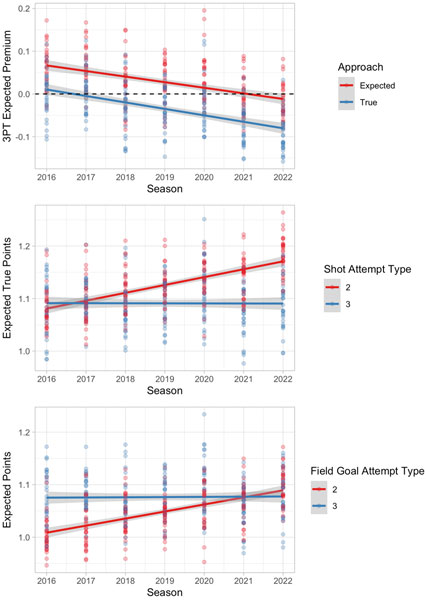
When the NBA celebrated the start of its 75th season in the Fall of 2021, it was clear that the 3-point shot adopted by the league in 1979-80 had transformed the sport.
The number of attempts beyond the arc had increased in the each of the previous 10 seasons, from 22.2% in 2010-11 to 39.2% in 2020-21, and it had been nearly five years since a team won a game without making at least one 3-pointer (that streak is now up to eight years). Led by 3-point specialists Steph Curry and Klay Thompson, the Golden State Warriors had won three of the previous seven NBA titles and were about to win a fourth in 2022.
It appeared the 3-point revolution would never end. But a recent study by Falk College sport analytics Professor Shane Sanders and Associate Professor Justin Ehrlich shows that while the number of 3-point shots continues to increase, the average expected value of 3-pointers has become less than 2-pointers since the 2017-18 season.
“When taking fouled shots and made free throws into consideration, we found that what had long been a premium for the 3-point shot started to become a dispremium in the 2017-18 season and that trend is continuing,” Ehrlich says. “The implication of these findings is enormous in terms of potential impact on roster construction and offensive philosophies.”
The research preprint from Sanders and Ehrlich, called “Estimating NBA Team Shot Selection Efficiency from Aggregations of True, Continuous Shot Charts: A Generalized Additive Model Approach,” is available through the Social Science Research Network website. Sanders and Ehrlich will present their paper as one of seven finalists in the research competition at the NBA-centric MIT Sloan Sports Analytics Conference March 1-2 in Boston.
“In past conferences, there has been a lot of discussion among NBA executives about how basketball analytics created the 3-point ‘moneyball’ era of basketball and how this has impacted the popularity of the game,” Sanders says. “Perhaps ironically, our research uses basketball analytics, along with a fully specified team offensive objective function, to say there is now too much 3-point shooting for a point-maximizing offense.”
To conduct their research, Sanders and Ehrlich developed a new shot chart that uses a generalized additive model (GAM) to estimate total shot proficiency continuously in the half-court. Their shot chart incorporates missed shots that draw a shooting foul – and shot-pursuant free throw scoring – to determine total scoring yield following a shot decision.
Current expected value formulas fall short by not including this additional information, which, when combined with the outcome of the initial shot attempt, result in what Sanders and Ehrlich call “true point value” of a shot.

True Value from 3P shot attempts=1.094
(2022-23 NBA season)And even when not factoring in free throws, the researchers found that the expected value from 3-point shots are now worth less than 2-point shots:
Expected value from 2P field goal attempt=2P% * 2 = .548 * 2= 1.096
Expected value from 3P field goal attempt=3P% * 3 = .361 * 3= 1.083
(2022-23 NBA season)
According to this research, the expected value from average 2-point field goal attempts (FGA) is now worth 0.013 points more than average 3-point FGA, even before factoring in shot-pursuant free throw scoring. In other words, if you multiply the probability of making a 3-point FGA times the value of a 3-point FGA, it’s worth less than if you multiple a 2-point FGA times the value of a 2-point FGA.
When discussing true point value, the researchers use the term “shot attempts” instead of “field goal attempts” because their formula includes missed shots when a player is fouled, which is not included in standard field-goal attempt statistics. So, when including made and missed free throws, the disparity based on this new true value metric is even greater as average 2-point shot attempts are now worth 0.087 more points than 3-point shot attempts.
Officials from NBA teams and the league have discussed moving the 3-point line back from its current distance of 23 feet, 9 inches (22 feet in the corners). But as this study shows, the value of a 3-pointer is decreasing at the current distance, and teams are already starting to alter their shot selection to emphasize more high-percentage 2-point shots.
“These research findings do not coincide completely with the unresearched musings of NBA analysts Charles Barkley and Shaquille O’Neal,” Sanders says. “For example, our findings do not suggest that such perimeter stars as Stephen Curry or Damian Lillard should not shoot a lot of threes.
“It means marginal stretch fours and other marginal outside shooters should not pull up for a 3 as often and that some marginal outside shooters should not extend their range to 25-26 feet or more,” Sanders says. “Players can still achieve the offensive spacing benefits of positioning on the perimeter without some players shooting from there quite as often.”
